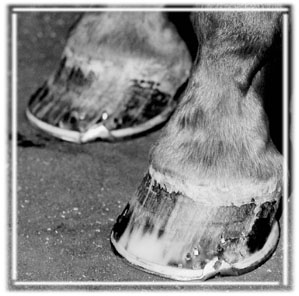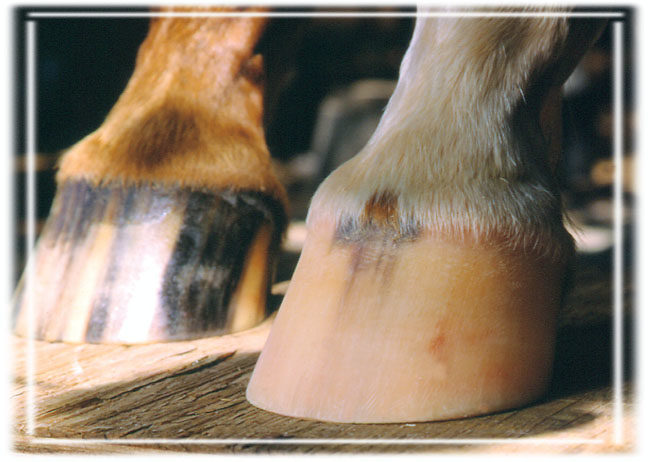TO EXPLAIN THE VALUE of horses with light hooves, farriers came up with a saying a long time ago:
One white foot, buy him;
Two white feet, try him;
Three white feet, deny him;
Four white feet and a white nose — take off his hide and feed him to the crows.
While shoers aren’t about to put down a horse with all white feet, the saying demonstrates the passion surrounding this black vs. white hooves debate.
Science has been trying to prove that this poem is a myth, but many farriers today still believe that white hooves are structurally weaker than their darker counterparts.
Color-Doesn’t-Matter Argument
Some farriers are convinced that the color of a foot can be directly related to whether that hoof is going to be strong or weak. However, there are many shoers who will not accept that rationale and claim that the “white is weaker” explanation is just a myth.
“The color of the hoof has little to do with strength, although just about everyone that asks me thinks that a darker hoof is stronger than light,” says Miles Courchesne, Mackay, Alberta, Canada. “I’ve found that hoof strength has more to do with capsule shape; with the rounder being the better.”
Most farriers base the conclusion that there is no difference between hoof color on practical experience.
“I have had white hooves hold shoes longer than some black hooves and vice versa,” says Sarah Cook.
“I have seen bad feet in both colors,” adds Dick Davis of Williamsport, Md. “It all depends on the health of the horse and its environment.”
Looking at a horse may be one way to decide this debate, but a few farriers say that looks can be deceiving.
“Sometimes white feet look worse because they are a little translucent, which will cause you to see more cracks than you would on a dark foot,” says Taryn Waddell, Cane Hill, Ark.
“It seems as though the white feet are more of a problem than pigmented feet because the damage is more apparent,” says Rob Sigafoos, Chief of Farrier Services at the University of Pennsylvania Veterinary School in New Bolton, Pa. “This is due to a greater contrast between the white horn and the darker color of the cracks of other hoof-wall damage.”

DOES PIGMENT EQUAL DURABILITY? Many farriers polled suggested that a dark hoof will not be as brittle as a white one.
“Perhaps the association of color and strength in people’s minds has more to do with the weaker feet that tend to crop up in certain breeds, and those breeds also may tend to have white feet,” offers Jennifer Inch of Yellowknife, Northern Territory, Canada.
Shoers who believe that there is no difference in strength of hooves based on color also point out that they see just as many problems with dark feet as they do with light.
“The horses I’ve seen with poor white feet also seem to have other conformational problems such as weak (underrun) heels, thin walls and thin soles,” says Gary Schwartz of McBride, British Columbia, Canada. “This is more an indication of poor genetics rather than the color of the feet because I’ve also seen these same problems on horses with black feet.”
“I don’t find that hoof color has anything to do with ‘healthy’ foot strength. I do find that darker hooves have a tendency to be harder, and, depending on your climate, they may wear better on a barefoot horse,” says Abby Kopp of Falkland, British Columbia, Canada. “By the same token, being of a harder consistency in a drier climate causes these hooves to lose resiliency and they have a tendency to become brittle and break.”
White-Is-Weaker Argument
Along the same lines, some farriers feel strongly that according to their observations, a white hoof is a weak hoof.
“While theoretically there should be no difference in the hoof color affecting the quality of the tubules, white hooves tend to be softer and break off easier if the hoof is not properly rounded off after trimming,” says Kelly Burns of Archbold, Ohio.
“It does seem like if I run into a horse with very soft hooves then all four hooves are light,” says Ed Boyd of Hillsboro, Ill. “And, if I run into a horse with hooves like iron, then all four hooves are dark. I haven’t seen a difference in light and dark hooves mixed on the same horse.”
“Horses with four white hooves or with two white hooves on the front or back seem to be just as strong or weak as the next horse, with color not making a difference,” says Denise Lynn of Hondo, Texas. “But I have noticed in horses with three dark hooves and one white hoof that the one white hoof wall will be weaker than the other three dark hooves on the same horse.”
Science Agrees With No-Difference Stance
While there hasn’t been extensive research done comparing the strength of light hooves against dark hooves, all of the scientific information rests with the argument that there is no strength difference in color of hooves.
Dr. Doug Butler’s 1974 text The Principles of Horseshoeing II dedicates a small section to this very debate.
“Pigmentation (color) of the hoof does not affect its compression-yield strength,” writes Butler. “There is no significant difference in moisture content or hoof hardness between white and black feet on the same horse.”

JUST AS STRONG. Scientific research firmly stands on the side of the farriers who say hoof pigment makes no difference when it comes to durability.
Agreeing with Butler’s assessment is Dr. Beth Valentine, a veterinary pathologist at Oregon State University.
“The only difference between the structure of pigmented hooves and the structure of non-pigmented hooves is the melanin granule content in the pigmented hoof,” says Valentine. “Although I have heard some theories that the presence of these microscopic melanin granules might keep a hoof crack or defect from spreading as far as it might in a non-pigmented hoof wall, this makes no sense to me.
“How could a microscopic molecule exert such strength? Certainly, pigmented skin is not stronger or more resistant to injury than non-pigmented skin.”
Two other horse professionals who agree that hoof strength is not determined by hoof color, pointed to a pair of studies to back up their claims.
Nancy Loving, an equine veterinarian from Boulder, Colo., cites the “Mechanical Properties of Equine Hooves,” which appeared in the American Journal of Veterinary Research in January of 1983. She says the report indicates that there is “no difference in the stress and strain behavior or ultimate strength properties between black and white hooves.”
Eli Wolf, a farrier and equipodiatrist from Robertson County, Texas, offers an English research project that was published in the Journal of Experimental Biology in 1996. The article was entitled “The Modulus of Elasticity of Equine Hoof Wall: Implications for the Mechanical Function of the Hoof.”
After carefully studying the research, Wolf concludes that, “contrary to popular assertions that white hooves are mechanically inferior, horn pigmentation makes no detectable difference.”
Wolf takes the light vs. dark hoof debate a step further and believes that today’s farriers are pushing old wives’ tales instead of scientific research.
“Pigment has absolutely nothing to do with tubule strength or overall hoof durability,” he says. “That is an old fable propagated by uninformed people, who, like old dogs, are difficult to retrain. This fable is being picked up by younger farriers who are too undermotivated to do the research and find out for themselves that this is hogwash.”
Related Content: Hoof Pigment Plays No Role in Structural Integrity








Post a comment
Report Abusive Comment